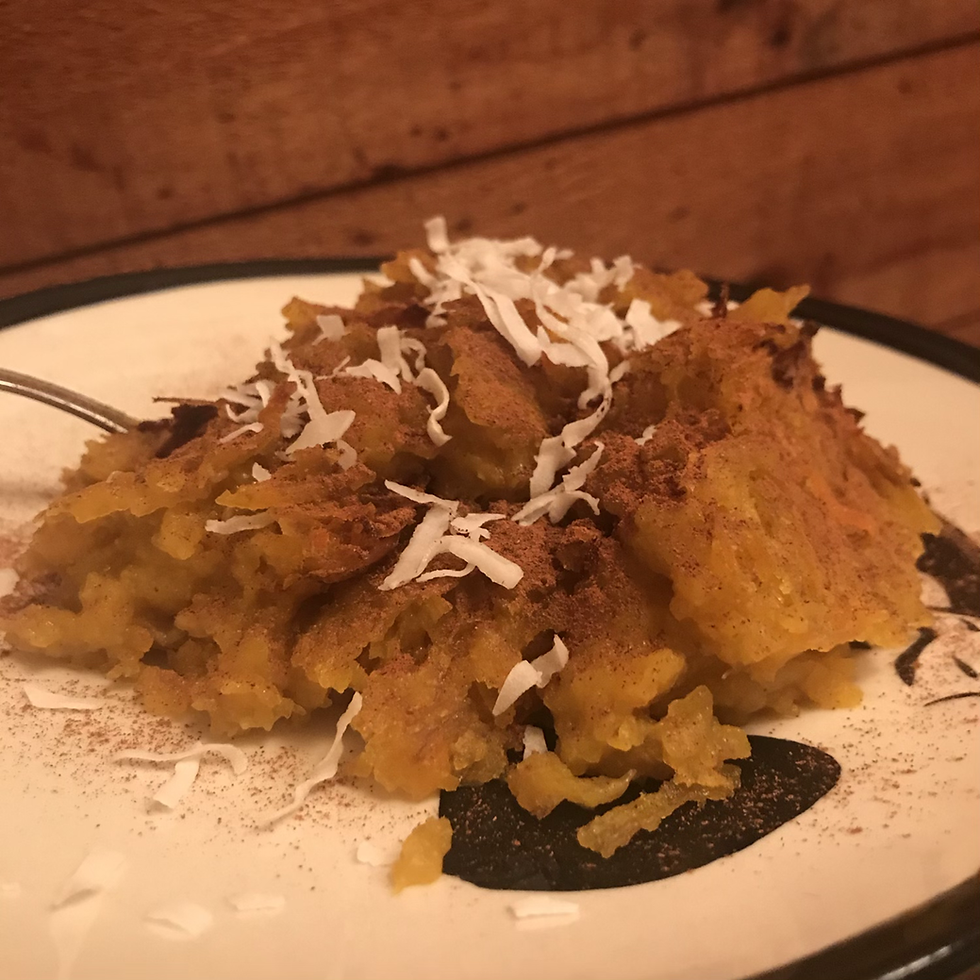Solomon Islands
- Kaitlin Shiner
- Apr 25, 2020
- 3 min read

It was tough to find recipes for the Solomon Islands, a country consisting of over 900 islands. However, besides fish, what stood out is that the inhabitants of this country eat a lot of cassava, sweet potato, and coconut. I've found that's a common thread with some of the Oceanic countries. With a lack of variety of vegetables, root vegetables, coconut, and fish are the main stars. The two popular "around the world" cooking blogs, who did this project way before me, made cassava pudding for Solomon Islands (I'm guessing one actually copied the other's recipe). So, I decided to do the same, but without claiming it as my own recipe.

The recipe starts with cassava, a starchy white tuber that takes a lot of time to prepare correctly and safely. It's actually the same plant we get tapioca from, which is the starch extracted from the root.

The first part of preparing the cassava is peeling it. It's covered in a waxy outer peel which is not as difficult to get off as I assumed. After peeling, you then have to remove the woody strings in the center. Those apparently contain cyanide and could make you sick. It took me forever to prep these cassavas. One source I read said that if there were black dots throughout, that the cassava is past its prime. Mine had lots of black spots so I ended up cutting away a good bit of it. Oh well. I was already shocked to be able to find this at a local grocery store in northern Vermont, so I honestly wasn't too concerned.

Prepping the sweet potato next was so much easier. I literally just had to peel it. The recipe called for a white sweet potato, probably meaning a yam; the closest I could find was a batata, which is a Caribbean white sweet potato. It's not truly white, but a little yellowish. But definitely not the bright orange you would see in American supermarkets.

I shredded and then pulsed both the cassava and sweet potato in my food processor. I wasn't about to grate them by hand after spending like an hour just trying to cut all the bad parts out.

Next, I squeezed as much of the liquid out as possible. Luckily, I had asked for some cheesecloth for Christmas, precisely for recipes like these. I've used clean kitchen towels for similar jobs in the past, and it's definitely not as easy.

Since I did it in batches, I ended up with several weird looking masses of molded sweet potato and cassava. They look...oddly fleshy yet like they're made of cloth themselves. That picture makes me uncomfortable.

So anyway, once the strained liquid sits in a bowl for a few minutes it starts to separate. The starch ends up on the bottom, and you can pour out the watery bit and be left with just that. The starch is then added back to the mixture to help hold everything together.

The grated stuff gets mixed with coconut milk and the leftover starch. I also added a little bit of sugar and vanilla because I was worried it was just going to taste like starch. The recipe just seemed too simple to actually taste good. I had also found a couple other recipes that used sugar. I'm glad I did add it, because it did taste just lightly sweetened.

The mixture would normally be put onto a banana leaf and heated over hot rocks, but I didn't feel like looking all over for some banana leaves, so I just used parchment paper and a casserole dish. The parchment paper came up and over to cover it all and help it steam, rather than just burn on top.
The recipe I used said to let it bake for three and half hours. I don't remember how long I ended up cooking it for. I think I put it in the oven before making dinner and took it out after we were done eating. As it sits at room temperature, it solidifies a little. The texture is not as you would think a pudding would be, even if you're British. It's really hard to describe the texture. It almost tastes like a really moist cake, but sticky and a bit chewy around the edges. Definitely one of the more unique things I've cooked for this project! I really enjoyed the taste, but I don't think it's one I'll be making again, if only for the sheer amount of work involved.
Recipes Used: Cassava Pudding // How to Make Cassava Pudding



Comments